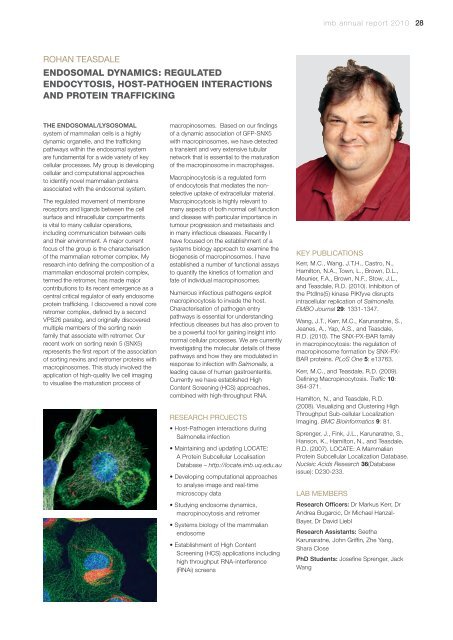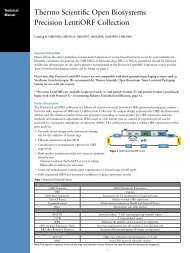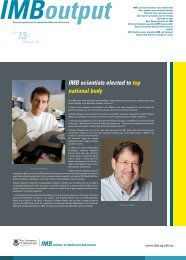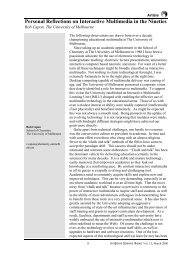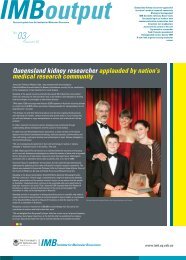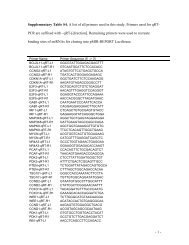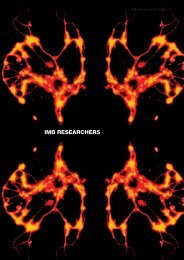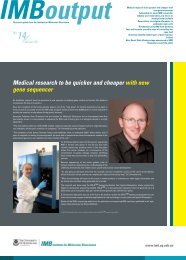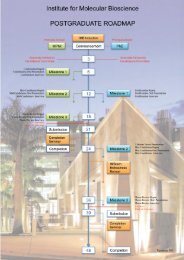2010 Annual Report - Institute for Molecular Bioscience - University ...
2010 Annual Report - Institute for Molecular Bioscience - University ...
2010 Annual Report - Institute for Molecular Bioscience - University ...
You also want an ePaper? Increase the reach of your titles
YUMPU automatically turns print PDFs into web optimized ePapers that Google loves.
imb annual report <strong>2010</strong><br />
28<br />
ROHAN TEASDALE<br />
ENDOSOMAL DYNAMICS: REGULATED<br />
ENDOCYTOSIS, HOST-PATHOGEN INTERACTIONS<br />
AND PROTEIN TRAFFICKING<br />
THE ENDOSOMAL/LYSOSOMAL<br />
system of mammalian cells is a highly<br />
dynamic organelle, and the trafficking<br />
pathways within the endosomal system<br />
are fundamental <strong>for</strong> a wide variety of key<br />
cellular processes. My group is developing<br />
cellular and computational approaches<br />
to identify novel mammalian proteins<br />
associated with the endosomal system.<br />
The regulated movement of membrane<br />
receptors and ligands between the cell<br />
surface and intracellular compartments<br />
is vital to many cellular operations,<br />
including communication between cells<br />
and their environment. A major current<br />
focus of the group is the characterisation<br />
of the mammalian retromer complex. My<br />
research into defining the composition of a<br />
mammalian endosomal protein complex,<br />
termed the retromer, has made major<br />
contributions to its recent emergence as a<br />
central critical regulator of early endosome<br />
protein trafficking. I discovered a novel core<br />
retromer complex, defined by a second<br />
VPS26 paralog, and originally discovered<br />
multiple members of the sorting nexin<br />
family that associate with retromer. Our<br />
recent work on sorting nexin 5 (SNX5)<br />
represents the first report of the association<br />
of sorting nexins and retromer proteins with<br />
macropinosomes. This study involved the<br />
application of high-quality live cell imaging<br />
to visualise the maturation process of<br />
macropinosomes. Based on our findings<br />
of a dynamic association of GFP-SNX5<br />
with macropinosomes, we have detected<br />
a transient and very extensive tubular<br />
network that is essential to the maturation<br />
of the macropinosome in macrophages.<br />
Macropinocytosis is a regulated <strong>for</strong>m<br />
of endocytosis that mediates the nonselective<br />
uptake of extracellular material.<br />
Macropinocytosis is highly relevant to<br />
many aspects of both normal cell function<br />
and disease with particular importance in<br />
tumour progression and metastasis and<br />
in many infectious diseases. Recently I<br />
have focused on the establishment of a<br />
systems biology approach to examine the<br />
biogenesis of macropinosomes. I have<br />
established a number of functional assays<br />
to quantify the kinetics of <strong>for</strong>mation and<br />
fate of individual macropinosomes.<br />
Numerous infectious pathogens exploit<br />
macropinocytosis to invade the host.<br />
Characterisation of pathogen entry<br />
pathways is essential <strong>for</strong> understanding<br />
infectious diseases but has also proven to<br />
be a powerful tool <strong>for</strong> gaining insight into<br />
normal cellular processes. We are currently<br />
investigating the molecular details of these<br />
pathways and how they are modulated in<br />
response to infection with Salmonella, a<br />
leading cause of human gastroenteritis.<br />
Currently we have established High<br />
Content Screening (HCS) approaches,<br />
combined with high-throughput RNA.<br />
RESEARCH PROJECTS<br />
• Host-Pathogen interactions during<br />
Salmonella infection<br />
• Maintaining and updating LOCATE:<br />
A Protein Subcellular Localisation<br />
Database – http://locate.imb.uq.edu.au<br />
• Developing computational approaches<br />
to analyse image and real-time<br />
microscopy data<br />
• Studying endosome dynamics,<br />
macropinocytosis and retromer<br />
• Systems biology of the mammalian<br />
endosome<br />
• Establishment of High Content<br />
Screening (HCS) applications including<br />
high throughput RNA-interference<br />
(RNAi) screens<br />
KEY PUBLICATIONS<br />
Kerr, M.C., Wang, J.T.H., Castro, N.,<br />
Hamilton, N.A., Town, L., Brown, D.L.,<br />
Meunier, F.A., Brown, N.F., Stow, J.L.,<br />
and Teasdale, R.D. (<strong>2010</strong>). Inhibition of<br />
the PtdIns(5) kinase PIKfyve disrupts<br />
intracellular replication of Salmonella.<br />
EMBO Journal 29: 1331-1347.<br />
Wang, J.T., Kerr, M.C., Karunaratne, S.,<br />
Jeanes, A., Yap, A.S., and Teasdale,<br />
R.D. (<strong>2010</strong>). The SNX-PX-BAR family<br />
in macropinocytosis: the regulation of<br />
macropinosome <strong>for</strong>mation by SNX-PX-<br />
BAR proteins. PLoS One 5: e13763.<br />
Kerr, M.C., and Teasdale, R.D. (2009).<br />
Defining Macropinocytosis. Traffic 10:<br />
364-371.<br />
Hamilton, N., and Teasdale, R.D.<br />
(2008). Visualizing and Clustering High<br />
Throughput Sub-cellular Localization<br />
Imaging. BMC Bioin<strong>for</strong>matics 9: 81.<br />
Sprenger, J., Fink, J.L., Karunaratne, S.,<br />
Hanson, K., Hamilton, N., and Teasdale,<br />
R.D. (2007). LOCATE: A Mammalian<br />
Protein Subcellular Localization Database.<br />
Nucleic Acids Research 36(Database<br />
issue): D230-233.<br />
LAB MEMBERS<br />
Research Officers: Dr Markus Kerr, Dr<br />
Andrea Bugarcic, Dr Michael Hanzal-<br />
Bayer, Dr David Liebl<br />
Research Assistants: Seetha<br />
Karunaratne, John Griffin, Zhe Yang,<br />
Shara Close<br />
PhD Students: Josefine Sprenger, Jack<br />
Wang


